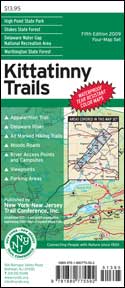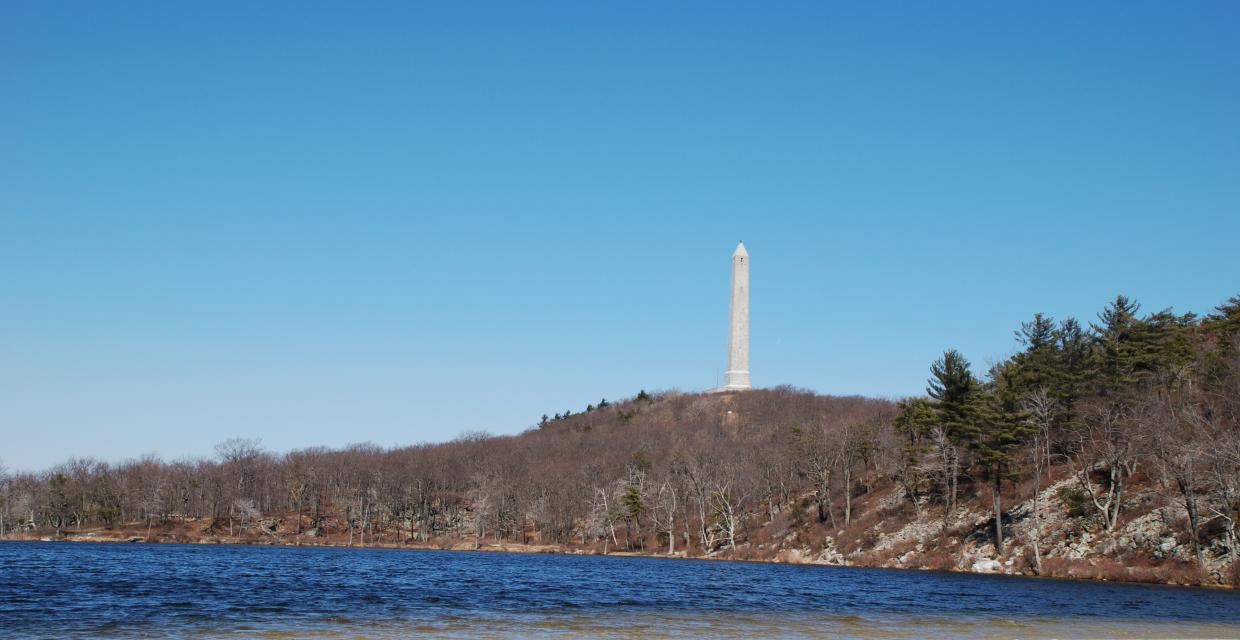Hike Description:

 Description: From Kittatinny Trails by Robert Boysen, 2004, New York-New Jersey Trail Conference
Description: From Kittatinny Trails by Robert Boysen, 2004, New York-New Jersey Trail Conference
A good place to start is in the High Point Monument parking area. There are views in all directions from the lot. Proceeding northeast along the ridge line, there are multiple views of the Great Valley, especially in winter.
The trail then descends to the north, crossing a small stream over a bridge at 1.1 miles and looping back to the southwest just short of the New York-New Jersey border.
At 1.7 miles from the monument parking area, the Shawangnk Ridge Trail leaves to the right. This trail extends along the Shawangunk Ridge to the Long Path, 30 miles to the north.
Views to the northwest toward Pennsylvania now emerge, until the path again descends to a small stream and to the Steeny Kill Trail on the right at 2.45 miles.
Beyond the stream, crossed on a footbridge, the trail rises steeply on rock steps. The climb is almost 300 feet and the slope about 20 percent, but the stone steps make it relatively easy going.
Next the trail descends about 100 feet to a park road, which it follows for 100 yards before crossing Kuser Road to the shore of Lake Marcia. It follows the northeast shore of the lake for about 200 yards and veers left up the hillside on a very rough trail. It crosses Scenic Drive park road and contacts the Appalachian Trail at 3.1 miles, then veers left to cross another park road before finally ascending to the High Point Monument.
It is about a 250-foot climb from Lake Marcia to the monument done in about 0.3 mile (17% average slope). The Shawangunk Ridge Trail starts where the AT contacts the Monument Trail and is co-aligned with the Monument and Kuser Trails before leaving to the north.
Trail Surface
From the monument parking area, all the way to the second stream crossing near the Steeny Kill Trail intersection, the trail is a moderatae to lightly stony woods path.
The climb after the second stream crossing is mostly on rock steps, obviously installed with a great deal of work many years ago (probably by the CCC).
Along Lake Marcia the trail is wider and practially stone free. When the trail veers away from the lake before ascending the final High Point Monument hill, it is extremely rough with many large boulders and is totally stone covered in sections. This part of the trail can be easily avoided, however, simply by walking the park roads back to the monument.
Scenery/Points of Interest
High Point State Park lands were donated by Colonel Anthony and Susie Dryden Kuser in 1923. The highest point in New Jersey is marked by the obelisk-shaped 220-foot-tall monument, the base of which is at 1,803 feet above sea level. Views from the monument and from the area surrounding it are quite spectacular, including the towns of Port Jervis, NY, and Matamoras, PA. The tower construction was completed in 1930.
Lake Marcia is a spring-fed natural lake and has a swimming beach.
The Cedar Swamp area inside the loop of the Monument Trail is preserved as a "natural area." It is timbered with eastern white cedar. A self-guided trail booklet is available from the park headquarters.
Climbing
There are two steep climbs already mentioned, one just southwest of the Steeny Kill Trail, and a second just prior to the monument itself. Each is about 250 feet with slopes in the 15% to 20% range. All other slopes are quite gradual. From the lowest point on the trail to the highest point at the monument is 350 feet.
Same Hike, Another Perspective
For another hiker's description of this same hike, click here.


This loop trail touches the High Point obelisk, the New York border and little Lake Marcia, and is among the most popular trails in the Kittatinny range.
Hike Checklist:
Whether you are going for a day hike or backpacking overnight, it is good practice to carry what we call The Hiking Essentials. These essentials will help you enjoy your outing more and will provide basic safety gear if needed. There may also be more essentials, depending on the season and your needs.
The Essentials
Hiking Shoes or Boots
Water - Two quarts per person is recommended in every season. Keep in mind that fluid loss is heightened in winter as well as summer. Don't put yourself in the position of having to end your hike early because you have run out of water.
Map - Know where you are and where you are going. Many of our hiking areas feature interconnecting network of trails. Use a waterproof/tear-resistant Tyvek Trail Conference map if available or enclose your map in a Ziplock plastic bag. If you have a mobile device, download Avenza’s free PDF Maps app and grab some GPS-enhanced Trail Conference maps (a backup Tyvek or paper version of the map is good to have just in case your batteries die or you don't have service). Check out some map-reading basics here.
Food - Snacks/lunch will keep you going as you burn energy walking or climbing. Nuts, seeds, and chocolate are favorites on the trail.
Sunscreen and insect repellent
Rain Gear and Extra Clothing - Rain happens. So does cold. Be prepared for changing weather. Avoid cotton--it traps water against your skin and is slow to dry. If you are wearing wet cotton and must return to your starting point, you risk getting chills that may lead to a dangerous hypothermia. Choose synthetic shirts, sweaters and/or vests and dress in layers for easy on and off.
Compass - A simple compass is all you need to orient you and your map to magnetic north.
Light - A flashlight or small, lightweight headlamp will be welcome gear if you find yourself still on the trail when darkness falls. Check the batteries before you start out and have extras in your pack.
First Aid Kit - Keep it simple, compact, and weatherproof. Know how to use the basic components.
Firestarter and Matches - In an emergency, you may need to keep yourself or someone else warm until help arrives. A firestarter (this could be as simple as leftover birthday candles that are kept inside a waterproof container) and matches (again, make sure to keep them in a waterproof container) could save a life.
Knife or Multi-tool - You may need to cut a piece of moleskin to put over a blister, repair a piece of broken equipment, or solve some other unexpected problem.
Emergency Numbers - Know the emergency numbers for the area you're going to and realize that in many locations--especially mountainous ones, your phone will not get reception.
Common Sense - Pay attention to your environment, your energy, and the condition of your companions. Has the weather turned rainy? Is daylight fading? Did you drink all your water? Did your companion fail to bring rain gear? Are you getting tired? Keep in mind that until you turn around you are (typically) only half-way to completing your hike--you must still get back to where you started from! (Exceptions are loop hikes.)
Check the weather forecast before you head out. Know the rules and regulations of the area.
The Leave No Trace Seven Principles
Plan Ahead and Prepare
- Know the regulations and special concerns for the area you'll visit.
- Prepare for extreme weather, hazards, and emergencies.
- Schedule your trip to avoid times of high use.
- Visit in small groups when possible. Consider splitting larger groups into smaller groups.
- Repackage food to minimize waste.
- Use a map and compass to eliminate the use of marking paint, rock cairns or flagging.
Travel and Camp on Durable Surfaces
- Durable surfaces include established trails and campsites, rock, gravel, dry grasses or snow.
- Protect riparian areas by camping at least 200 feet from lakes and streams.
- Good campsites are found, not made. Altering a site is not necessary.
- In popular areas:
- Concentrate use on existing trails and campsites.
- Walk single file in the middle of the trail, even when wet or muddy.
- Keep campsites small. Focus activity in areas where vegetation is absent.
- In pristine areas:
- Disperse use to prevent the creation of campsites and trails.
- Avoid places where impacts are just beginning.
- Pack it in, pack it out. Inspect your campsite and rest areas for trash or spilled foods. Pack out all trash, leftover food and litter.
- Deposit solid human waste in catholes dug 6 to 8 inches deep, at least 200 feet from water, camp and trails. Cover and disguise the cathole when finished.
- Pack out toilet paper and hygiene products.
- To wash yourself or your dishes, carry water 200 feet away from streams or lakes and use small amounts of biodegradable soap. Scatter strained dishwater.
- Preserve the past: examine, but do not touch cultural or historic structures and artifacts.
- Leave rocks, plants and other natural objects as you find them.
- Avoid introducing or transporting non-native species.
- Do not build structures, furniture, or dig trenches.
- Campfires can cause lasting impacts to the backcountry. Use a lightweight stove for cooking and enjoy a candle lantern for light.
- Where fires are permitted, use established fire rings, fire pans, or mound fires.
- Keep fires small. Only use sticks from the ground that can be broken by hand.
- Burn all wood and coals to ash, put out campfires completely, then scatter cool ashes.
- Observe wildlife from a distance. Do not follow or approach them.
- Never feed animals. Feeding wildlife damages their health, alters natural behaviors, and exposes them to predators and other dangers.
- Protect wildlife and your food by storing rations and trash securely.
- Control pets at all times, or leave them at home.
- Avoid wildlife during sensitive times: mating, nesting, raising young, or winter.
Be Considerate of Other Visitors
- Respect other visitors and protect the quality of their experience.
- Be courteous. Yield to other users on the trail.
- Step to the downhill side of the trail when encountering pack stock.
- Take breaks and camp away from trails and other visitors.
- Let nature's sounds prevail. Avoid loud voices and noises.
The Trail Conference is a 2015 Leave No Trace partner.
(c) Leave No Trace Center for Outdoor Ethics: www.LNT.org.


